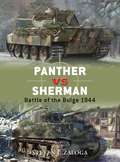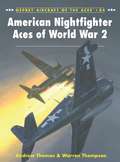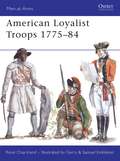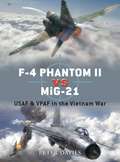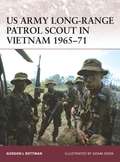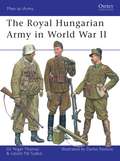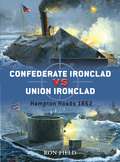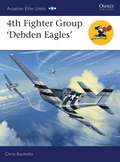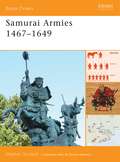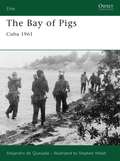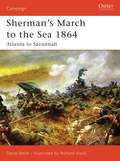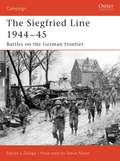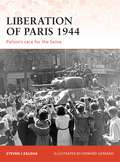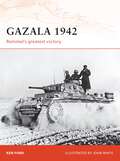- Table View
- List View
World War II Street-Fighting Tactics (Elite)
by Peter Dennis Stephen BullIn a continuation of the tactics mini-series, this book analyzes the physical tactics of the close-quarter fighting that took place in ruined cities during World War II. Street-to-street fighting in cities was not a new development, but the bombed-out shells of cities and advances in weaponry meant that World War II took such strategies to a new level of savagery and violence. Packed with eye-witness accounts, tutorials from original training manuals, maps, and full-colour artwork, this is an eye-opening insight into the tactics and experiences of infantry fighting their way through ruined cities in the face of heavy casualty rates and vicious resistance.
Panther vs Sherman: Battle of the Bulge 1944 (Duel #13)
by Steven J. Zaloga Howard Gerrard Jim LaurierIn this book Steven J Zaloga offers a fascinating comparison between the two most important tanks involved in the crucial fighting of 1944, the American Sherman and the German Panther. Placing the reader in the heart of this battle between quality and quantity Zaloga uses a compelling account of the ferocious fighting during the Battle of the Bulge to explain the successes and failures of each tank, highlighting the fact that a tank can only be as good as its crew, weighing up the impact of low morale, high cost and mediocre crew training on the Panther's superiority. With full-colour battlescenes, technical drawings, photographs, digital gunsight views, extracts from crew training manuals and real combat reports, this book brings the titanic battles between the Panther and Sherman to life.
The German Fortress of Metz 1870–1944 (Fortress #78)
by Brian Delf Clayton DonnellFollowing the defeat of France in the Franco-Prussian War of 1870–71, the German Army began to construct a fortress line from Strasbourg to Luxembourg to protect their new territory, the centrepiece of which was the great Moselstellung (Moselle Position) of Metz / Thionville. Illustrated with rare photographs and full-colour cutaway artwork, this book examines the design and development of the fortress and analyses its use in combat, focusing particularly on the part it played in holding up General Patton's Third Army's advance across France in 1944.
American Nightfighter Aces of World War 2 (Aircraft of the Aces)
by Chris Davey Andrew Thomas Warren Thompson Mark PostlethwaiteThe Americans lagged behind their European contemporaries in military aviation in the late 1930s, and it took the Battle of Britain to awaken America to the necessity of having aircraft that could defend targets against night-time attack by bomber aircraft. This book examines the numerous aircraft types that were used by the US in this role, beginning with the early stop-gap conversions like the TBM Avenger, Lockheed Ventura and the A-20 Havoc (P-70). It goes on to detail the combat history of the newer, radar-equipped Hellcats, Corsairs and Black Widows that were designed to seek out enemy aircraft and which registered most of the kills made by the Navy, Marine Corps and USAAF in 1944–45. With full-colour profiles and rare photographs, this is an absorbing account of an underestimated flying force: the American Nightfighters.
American Loyalist Troops 1775–84 (Men-at-Arms)
by Gerry Embleton Ian Rotherham René ChartrandTo celebrate the 450th title in the Men-at-Arms series, this book examines in much more depth than previously the units and the uniforms of a still-controversial army: the many thousands of American colonists who chose to fight for King George during the Revolution. As well as the better-known corps from the Atlantic seaboard, the author covers the units raised for service against the Spanish in the Floridas, the Caribbean islands and Central America. The text is illustrated with portraits, photographs of rare surviving artefacts, and with color reconstructions by Gerry Embleton, the respected expert on 18th century American forces whose work was recently exhibited in the Smithsonian Institute.
F-4 Phantom II vs MiG-21: USAF & VPAF in the Vietnam War (Duel #12)
by Jim Laurier Tom Tullis Gareth Hector Peter E. DaviesThis book draws us into the dangerous world braved by American and North Vietnamese airmen in the skies over Vietnam. Influential leaders and tacticians are profiled to provide a comparative evaluation of their contrasting skills. This book also reveals the technical specifications of each jet with an analysis of the weaponry, avionics and survival devices of the F-4 Phantom II as flown by the USAF and the MiG-21. The fighters' strengths and weaknesses are also compared, including turn radius, performance at altitude, range and structural integrity. First-person extracts reflect on the dangers of these aerial duels, as USAF pilots and their counterparts struggled to overcome each plane's shortcomings.
US Army Long-Range Patrol Scout in Vietnam 1965-71 (Warrior)
by Adam Hook Gordon L. RottmanThe Vietnamese knew the Long-Range Patrol Scouts as "the men with green faces,†? a reference to the camouflage paint that they used. Operating in patrols of four to six men these men were like ghosts – scouting far behind enemy lines. This book examines the Long-Range Patrol Scout's superior stealth movement techniques, camouflage and concealment, tracking, counter-tracking, observation, and other fieldcraft skills. It also examines the occasions they participated in small-scale direct actions including ambushes and raids. Written by a Special Forces' Vietnam veteran, this book not only depicts the remarkable lives of these scouts when on campaign, but also details the training and conditioning that it took to become one of these shadow warriors.
Japan 1945: From Operation Downfall to Hiroshima and Nagasaki (Campaign)
by John White Clayton ChunIn this 200th Campaign series title Clayton Chun examines the final stages of World War II as the Allies debated how to bring about the surrender of Japan. He details Operation Downfall (the planned invasion of the Japanese home islands).Chun explains why these plans were never implemented, before examining the horrific alternative to military invasion – the attacks on Hiroshima and Nagasaki with nuclear weapons. With a series of illustrations, including detailed diagrams of the atomic bombs, a depiction of the different stages of the explosions and maps of the original invasion plans, this book provides a unique perspective of a key event in world history.
The Royal Hungarian Army in World War II (Men-at-Arms)
by Nigel Thomas Darko Pavlovic Laszlo SzaboThe Royal Hungarian Army was Germany's largest ally on the Eastern Front, but information about the Hungarian Army in English is rare. Deployed in Ukraine at the beginning of the war, the Hungarian Army was involved in a number of brutal encounters with the Red Army, including stubborn resistance in Transylvania in the summer of 1944, and the brave defense of Budapest in the face of overwhelming odds. The Hungarian Army was a varied and colourful force, ranging from mountain troops and tank units to horse cavalry and specialist infantry. All of these are illustrated in full-colour artwork, with full details about the Hungarian Army's own, quite distinct uniforms and insignia as well as many of its own weapons and tanks. This is an essential starter resource for wargamers, modelers, re-enactors and military historians.
Panzer Divisions: The Eastern Front 1941–43 (Battle Orders)
by Pier Paolo BattistelliOn 22 June 1941 Germany attacked the Soviet Union and her Panzer divisions were to play a major role in this titanic struggle. Although overwhelmed by Soviet numbers, the superior skill and capability of the German Panzer divisions meant that in three months the Germans had advanced deep into Soviet territory. However, after these initial successes the German offensive began to falter, culminating in the disastrous defeat at Kursk. This book describes the organisational history of the Panzer divisions, from the early successes of 1941 through to the introduction of revised Blitzkrieg tactics as the war progressed.
Osaka 1615: The last battle of the samurai (Campaign #170)
by Stephen Turnbull Richard HookIn 1614-15 Osaka Castle was Japan's greatest fortification, measuring approximately 2 miles in length with walls 100 feet high. It was guarded by 100,000 samurai, determined to defend the last of the once-powerful Toyotomi clan. The castle was seemingly impenetrable; however, Tokugawa Ieyasu, the founder of the ruling dynasty, was determined to destroy this remaining threat to the Tokuwaga ruling dynasty. This book explores the bitter struggle of the Summer and Winter campaigns, which eventually saw the last great clash of the samurai and defined the balance of power in Japan for years to come.
Confederate Ironclad vs Union Ironclad: Hampton Roads 1862 (Duel)
by Howard Gerrard Peter Bull Ron FieldThe Ironclad was a revolutionary weapon of war, the first modern, armoured, self-propelled warships. During the American Civil War the South used ironclads to protect their ports from the Northern blockade. Impressed with their superior resistance to fire and, the North developed its own rival fleet of ironclads. Eventually the two products of this modern arms race duelled at the battle of Hampton Roads in a clash that would change the face of naval warfare. Fully illustrated with cutting-edge digital artwork, rare photographs and first-person perspective gunsight views, this book allows the reader to discover the revolutionary and radically different designs of the two rival Ironclads – the Merrimac and USS Monitor – through an analysis of each ship's weaponry, ammunition and steerage.
War Elephants (New Vanguard)
by Peter Dennis Konstantin NossovElephants have been deployed as weapons for centuries, particularly in South and South-East Asia, where war elephants constituted the bulk of most armies in the region from antiquity right up to the 19th century. This book offers an insight into the incredible history of these 'living tanks,' focusing on the design of the equipment and armament that made them so terrifying. The author, Konstantin S Nossov, traces the history of war elephants, from their deployment against Alexander the Great's army at the battle of Gaugamela, through to their use in the 19th century by the armies of South-East Asia, analyzing the battle formation and tactics of war elephants in action and how these tactics developed.
The Russian Civil War 1918–22 (Essential Histories)
by David BullockThe Russian Civil War is the most important civil war of the 20th century, changing the lives of over half a billion people and dramatically shaping the geography of Europe, the Far East and Asia. Over a four-year period 20 countries battled in a crucible that would give birth to Communist revolutions worldwide and the Cold War. David Bullock offers a fresh perspective on this conflict, examining the forces involved, as well as the fascinating intervention by Allied forces. At the dawn of modern war, as cavalry duelled with tanks, aircraft, and armoured trains along shifting fronts, this title tells a military story enacted against a backdrop of political and social revolution and within the context of immense human loss. The reader cannot fail to be moved by the rare photographs and illustrations that make this history come alive.
Lockheed SR-71 Operations in the Far East (Combat Aircraft)
by Jim Laurier Chris Davey Paul F CrickmoreEven before the first operational flight of the U-2 spy plane, aircraft designers began work on the type's replacement. The result was the SR-71. First deployed on March 9, 1968, this tri-sonic 'hotrod' flew its first operational sortie over North Vietnam just 12 days later. Thereafter, the SR-71 roamed freely, capturing photographic, radar and electronic intelligence. This book examines the impact this aircraft had, not only on North Vietnam but during the Cold War as a whole, gathering information about the Soviet nuclear submarine fleet based in Vladivostok as well as the port's defenses, monitoring the actions of North Korea and flying four 11-hour, non-stop sorties into the Persian Gulf during the Iran-Iraq War in the late 1980s.
4th Fighter Group: Debden Eagles (Aviation Elite Units)
by Chris Davey Chris BucholtzFormed around a nucleus of pilots already seasoned by their experience as volunteers in the RAF's Eagle Squadrons, the 4th Fighter Group was established in England in October 1942. Initially flying Spitfires, the Debden Eagles went on to fly the P-47 and P-51, becoming, in July 1943, the first Eighth Air Force fighter group to penetrate German air space. The group's record of 583 air and 469 ground victories was unmatched in the Eighth Air Force, and the group produced a cast of characters that included legendary aces Don Blakeslee, Pierce McKennon, "Kid†? Hofer, Duane Beeson, Steve Pisanos and Howard Hively. Involved in the D-Day landings, Operation Market Garden, the Battle of the Bulge and the crossing of the Rhine, the group's achievements came at a high price, with a 42 percent casualty rate. Packed with first-hand accounts, detailed aircraft profiles and full combat histories, this book is an intriguing insight into the best-known American fighter unit in World War II
Samurai Armies 1467–1649 (Battle Orders)
by Stephen TurnbullThe Sengoku The Jidai, 'Age of Warring States', is the age of the samurai the military aristocracy of Japan. This period, which lasted from the outbreak of the Onin War in 1467 to the establishment of the Tokugawa Shogunate in the early 17th century, was a period of endemic warfare, when a lack of central control led to constant struggles between the daimyo, 'great names', who sought to extend the influence of their families through political and military means. This title will examine the complicated nature of family and clan that governed so much of the initial organization of the armies, how this changed over the period and how battlefield tactics developed over a series of major encounters such as Nagashino and Sekigahara.
The Bay of Pigs: Cuba 1961 (Elite)
by Stephen Walsh Alejandro De QuesadaThe landings by the Cuban exile Assault Brigade 2506 at the Bay of Pigs on April 17, 1961 led to three days of savage but unequal combat. Before they even sailed for Cuba, a White House decision had condemned them to constant attacks by Castro's air force, which sank two of their ships loaded with vital supplies and equipment. Despite stubborn resistance to Castro's troops and tanks, and heroic sorties by Cuban and American B-26 pilots, the Brigade was strangled for lack of firepower and ammunition. Their story is illustrated with rare photos from Brigade veterans, and detailed color plates of the uniforms and insignia of both sides.
Sherman's March to the Sea 1864: Atlanta to Savannah (Campaign #179)
by Richard Hook David SmithRiding on the wave of his victory at Atlanta, Union General W. T. Sherman abandoned his supply lines in an attempt to push his forces into Confederate territory and take Savannah. During their 285-mile 'March to the Sea' the army lived off the land and destroyed all war-making capabilities of the enemy en route. Despite the controversy surrounding it, the march was a success. Supported by photographs, detailed maps, and artwork, this title explores the key personalities and engagements of the march and provides a detailed analysis of the campaign that marked the 'beginning of the end' of the Civil War.
Siegfried Line 1944–45: Battles on the German frontier (Campaign)
by Steven J. Zaloga Steve NoonThe campaign on the German frontier in late 1944 was one of the most frustrating and costly efforts by the US Army in the ETO. The Allies first encountered the Siegfried Line (Westwall) fortifications in September 1944, having pursued the retreating Wehrmacht through Belgium and the Netherlands. The border area around Aachen had been fortified with a double line of bunkers, and both the terrain and the weather made things difficult for the Allies. This book focuses on the involvement of the US First and Ninth armies in the six-month fighting, including the hellish fighting for the Hürtgen forest.
Operation Barbarossa 1941: Army Group Center (Campaign)
by Peter Dennis Robert KirchubelThe final volume in the Barbarossa trilogy, this title complete the account of the strategic intricacies of the German campaign against Russia. Robert Kirchubel examines the causes behind the German failure, including the inability to resupply troops or provide reserves, as well as the lack of decent German winter uniforms and transport with dramatic contemporary photographs detailing the unforgiving battlefield conditions. Full-colour artwork, maps and bird's-eye-views illustrate the campaign in detail, revealing how, despite lapses and flaws in Soviet defences, the Red Army was able to capitalize on every German weakness.
New York 1776: The Continentals’ first battle (Campaign #192)
by Graham Turner David SmithGeneral Sir William Howe's New York campaign gave the British their best chance of destroying the Continental Army and George Washington's resistance to colonial power. Howe succeeded in dividing the Continentals, defeated them on Long Island and forced Washington to retreat to Brooklyn Heights. Under siege there, Washington successfully crossed the East River to Manhattan but soon had to fall back on Harlem Heights. After a few weeks Howe forced the Continentals north to White Plains and defeated them again. However, he allowed Washington to withdraw and preserve his army when a more aggressive pursuit could have ended the war. Instead, with the British army rapidly weakening and facing huge manpower shortages, Washington emerged from a succession of defeats to produce what was ultimately a war-winning strategy. The author provides fascinating insights into a unique campaign in which a string of British victories ultimately led to failure and defeat.
Liberation of Paris 1944: Patton’s race for the Seine (Campaign #194)
by Steven J. Zaloga Howard GerrardIn July 1944, Operation Cobra broke the stalemate in Normandy and sent the Allies racing across France. The Allied commanders had ignored Paris in their planning for this campaign, considering that the risk of intense street fighting and heavy casualties outweighed the city's strategic importance. However, Charles de Gaulle persuaded the Allied commanders to take direct action to liberate his nation's capital. Steven J Zaloga first describes the operations of Patton's Third Army as it advanced towards Paris before focussing on the actions of the Resistance forces inside the city and of the Free French armoured division that fought its way in and joined up with them to liberate it on the 24th August. On the back of this morale-boosting victory, De Gaulle could finally proclaim Paris to be liberated, as one of the world's loveliest cities survived Hitler's strident command that it should be held at all costs or razed to the ground.
Gazala 1942: Rommel's greatest victory (Campaign)
by John White Ken FordFollowing a lull in the desert war which saw the Germans and British reinforce their armies, Rommel suddenly attacked British fortifications with an assault on the northern sector of the British line near Gazala. Pinning down the British in the north and outflanking the 1st Free French Brigade, Rommel succeeded in encircling the main British positions, trapping them in what became known as 'The Cauldron'. With thousands of British soldiers killed or taken prisoner, this was a devastating defeat for the Allies. Accompanied by contemporary photographs and maps depicting the movement of both armies, Ken Ford provides a masterful study of Rommel, the 'Desert Fox', at the height of his powers as he swept the British army back to the site of their final stand at El Alamein.
The British Fleet Air Arm in World War II (Elite)
by Stephen Walsh Mark Barber Mark PostlethwaiteThis is a concise history of the Royal Navy's air arm during World War II, from their Arctic convoys, to the battle of Malta, and the last raids on Japan. Amazingly, the Admiralty only had 406 operational pilots and eight carriers when war broke out, but a mere six years later there were over 3,000 operational pilots and 53 aircraft carriers patrolling the seas in every theatre of the war. This book charts the rapid evolution of the Fleet Air Arm during the war as air power took over at the cutting edge of naval warfare. Mark Barber's account is highly illustrated with photographs and specially commissioned full-colour artwork and offers an overview of the British Fleet Air Arm, from recruitment and training through to combat accounts. Discover some of the most dramatic actions of the war as Royal Navy aces battled against the Axis forces scoring both the first and last kills of the war.

